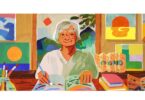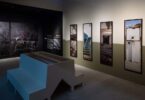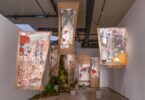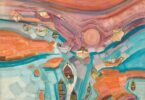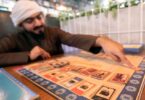Maan Jalal
Kuwaiti artist Monira Al Qadiri recently unveiled her sculpture Devonian at the Southbank Centre’s Riverside Terrace — one of the most prestigious plots of artistic real estate in London.
A shimmering, multicoloured, fossil-like structure, the piece is based on the bodies of ancient sea creatures to evoke the process by which fossil fuels are made, from the decomposed remains of ancient organisms and plankton found at the bottom of the oceans.
“To be able to show my work at the Southbank Centre is such an important milestone for my artistic journey thus far,” Al Qadiri says. “I hope that the public who pass by to see my work find the topic I am highlighting crucial to think about and consider during these shifting times that we live in.”
The project is the result of her partnership with the Bagri Foundation — a UK registered charity that supports Asian arts and culture. Al Qadiri says she is “honoured” to have been selected for the commission.
The non-profit organisation forges collaborative partnerships between artists and institutions such as the Hayward Gallery, part of the Southbank — the UK’s largest arts centre.
While working on Devonian, Al Qadiri studied the fossils of creatures that lived nearly 400 million years ago on Devon’s Jurassic Coast a Unesco World Heritage Site famed for its rocks, fossils and landforms.
“I researched mostly illustrations of them,” Al Qadiri told The National. “They had these crazy, science fictional-looking bodies and heads, where bones were on the top of their heads. They just looked like something out of a cartoon which really attracted me to them.”
While playful and visually stimulating, Devonian explores a timely issue: the exploitation of nature — specifically our reliance on fossil fuels.
“I’m from Kuwait, a country that is largely dependent on oil revenues,” Al Qadiri says. “I have a kind of existential relationship with oil and its history and its future as well.”
:quality(70)/cloudfront-eu-central-1.images.arcpublishing.com/thenational/2YREVRQTPBATHK7ASDSOPXFXO4.jpg)
Her work addresses our relationship with oil in an unexpectedly alluring way, which highlights the impact of fossil fuels on the environment.
“I believe the world needs to move past oil. It’s difficult to realise how fragile it is as a fuel source,” she says. “I make these works that revolve around visualising it in different ways in order to highlight what it’s made of, how we use it and that it’s unsustainable.”
Extinct, alien-like, crustaceans are reimagined in Al Qadiri’s work as a series of graphic motifs on eight separate aluminium panels, linked by a turquoise structure. The shapes and scale of the work lend themselves to a public space, which was a source of much consideration when Al Qadiri was conceptualising the sculpture.
“Public art is a very specific and difficult thing to do, and it’s very different from showing art work in a gallery or in a museum,” she says.
:quality(70)/cloudfront-eu-central-1.images.arcpublishing.com/thenational/ND2ZKLOZFRALNLNIHFYHYGIUNI.jpg)
“I had to really think hard about how the public would see and interact with it. Old people, children, people who aren’t interested in the arts, how do they see this work? What will make them interested in the topic that the work is about?”
Al Qadiri’s efforts were successful in piquing people’s interest.
Despite drawing on a prehistoric aesthetic, Devonian also feels very contemporary, owing to its scale and the shimmering hue that changes subtly over the course of the day.
The oil-like sheen on the surface of the sculpture is also reminiscent of the lustre seen on pearls. The effect elevates the optical experience of the work. The commonality in how colour is reflected on both oil and pearls, two seemingly opposing elements, is a relationship that Al Qadiri has been exploring in the Gulf for years.
This use of dazzling colour is a stylistic element seen in some of Al Qadiri’s other works. Her piece Chimera, a five-metre-tall sculpture, which was part of the Expo 2020 Dubai collection of public artworks, examined the Gulf’s history and future through scale and Al Qadiri’s signature colour palate.
:quality(70)/cloudfront-eu-central-1.images.arcpublishing.com/thenational/P2HTD6KZZZC4HEEKMIAPRCGXUY.jpg)
However, this iridescent and dichroic way of depicting colour is more than just a visual asset, but a thought-provoking reference to oil and the greater themes at play.
“In this work I wanted to make the colour of oil and make it more playful in a way,” Al Qadiri says.
“I’m highlighting the moment when all of these creatures came together and transformed into oil basically, through their colour and their form and how they fit together.”
Devonian is available for public viewing until November 6 at the Riverside Terrace in London.
Courtesy: thenationalnews

